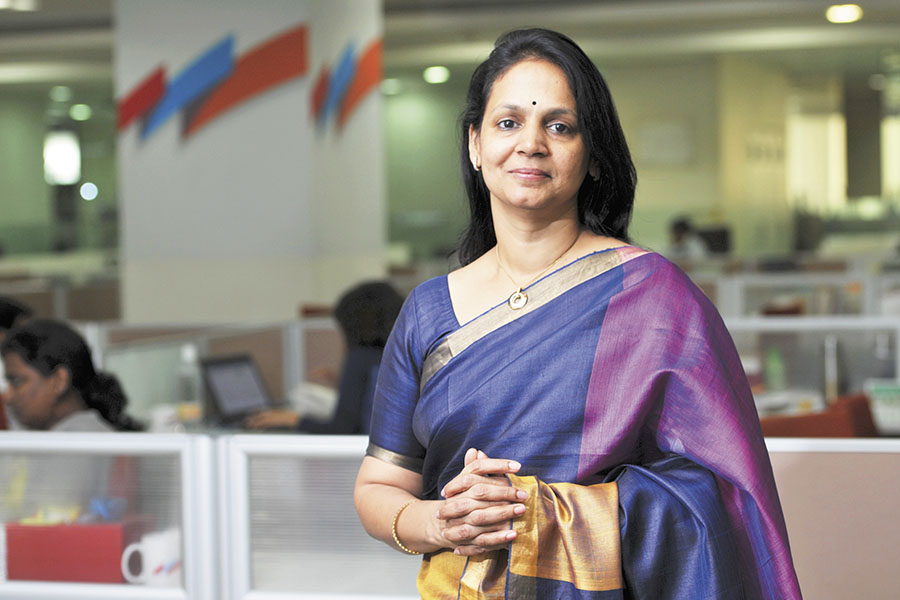
There is immense potential in the bancassurance model: RM Vishakha
The MD of IndiaFirst Life Insurance says the country's youth prefers to buy pure term insurance plans over money-back and endowment ones

RM Vishakha, MD of IndiaFirst Life Insurance
RM Vishakha, IndiaFirst’s managing director and chief executive officer, says there is more than enough headroom for her company—a three-way joint venture between Bank of Baroda, Andhra Bank and UK’s Legal & General—to grow through the bancassurance model. This even as it looks to increase the share of online sales in keeping with the new way of selling and buying financial products.
IndiaFirst, which recorded its third consecutive profitable year in FY17 with a fourfold year-on-year rise in net profit to ₹35 crore—on a new retail premium collection of ₹403 crore (up by 82 percent year-on-year)—is also looking at product innovation by attempting to tie up with marketplaces and aggregators of ecommerce services. The idea is to get an online marketplace or a cab aggregator to foster loyalty with their channel partners, such as sellers or drivers, by helping them with insurance policies that can compensate them for loss of income in case of hospitalisation.
In an interview with Forbes India, Vishakha explains why IndiaFirst’s experience of disbursing life insurance policies under the government’s Pradhan Mantri Jeevan Jyoti Bima Yojana (PMJJBY) has been a mixed bag. Edited excerpts:
Q. What are the emerging trends that you see in the way in which people purchase life insurance?
There is a growing awareness among the current generation about the need for life insurance as a security net in a volatile world where jobs aren’t guaranteed for a lifetime. There is greater awareness about the need for pure term plans and people are gradually moving away from money-back and endowment ones. Two years ago, when PMJJBY (a social welfare scheme that seeks to provide life insurance to masses at the bottom of the pyramid at a low-cost premium) was launched, it led to an increase of risk awareness among the semi-urban and rural population as well, and not just the financially sound and well-to-do.
Q. How has your experience been with PMJJBY?
PMJJBY was both an opportunity and a setback for us. We got to cover close to 25 lakh people and participate in the government’s path-breaking policy. Also, we have to admit that the claims ratio (ratio of claims to premium paid) has been pretty high. We are seeing this ratio stabilise now, but in the first year it was as high as 150 percent.
“ Life insurance is seen as a security net in a world where jobs aren’t guaranteed.
Q. Why was the claims ratio so high?
When we price a life insurance product, the benchmark calculation for deaths per thousand is 2.3-2.4. But the pricing under PMJJBY was not made for more than 1.1 deaths per thousand. In life insurance, what we do is screen a person and then underwrite the policy based on our assessment of the timing of her death. We screen the person to ensure that he doesn’t know when he is going to die. This is typically done by obtaining a Declaration of Good Health for smaller ticket-size policies or following an ‘exclusion period’—a waiting period after which the policy is issued to ensure that the person is not on his/her deathbed. In the first year of PMJJBY, we didn’t have either of the two clauses. There was a maximum age of 50 years [to be eligible for the scheme], but anybody below that age who knew he was going to die got a policy.
We believe that out of the 150 percent claims ratio that we witnessed, 30 percent was anti-selection (people who wouldn’t have qualified for insurance cover following the standard screening process). In the next year of the policy, a 45-day exclusion period was introduced, which led to a better experience. We will be happy if the claims ratio for policies under this scheme doesn’t exceed 100-110 percent.
Q. Can the PMJJBY business be economically viable?
I do think it is revenue generating. But it needs to have more subscribers for it to become a profitable product for insurance companies instead of just being a break-even proposition.
Q. At a time when the country’s young population is buying insurance online, how much of growth can IndiaFirst expect from the bancassurance model that it follows?
We have stabilised the bancassurance business and there is still immense potential in that channel waiting to be tapped. The customer segment in bancassurance is completely different from those buying term policies online. The bancassurance model has a lot of customers engaged with small and medium enterprises and agriculture. They want to harness their money and keep some amount of stability since their income is volatile (unlike those of the salaried class). The customer base of both our promoter banks put together is 10 crore and we have 50 lakh customers from this base. So, there is significant potential for further penetration in this low-cost channel. However, we are aware that the youth of the country is buying term policies online and the focus for the future is to strengthen our internet base.
(This story appears in the 01 September, 2017 issue of Forbes India. To visit our Archives, click here.)
Post Your Comment














